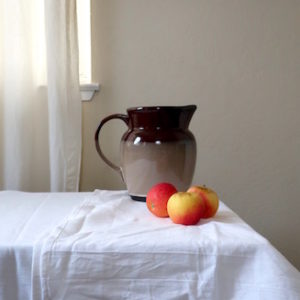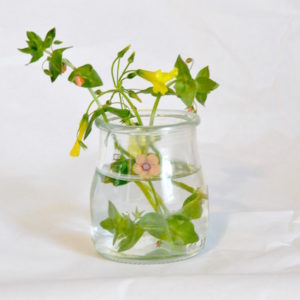Okra Pilau
Thursday evening the doorbell rang. Our visitors were two boys who live in the apartment building next door. Their basketball had sailed over the fence dividing our properties, landing in our yard. This is not an infrequent occurrence.
These are nice kids–well-behaved and remarkably polite. I retrieved the ball, then led the boys to the side gate and showed them how to unlatch it. “You’re welcome to come get your ball any time. Just don’t tell the neighborhood how the gate works, okay?”
We shook on it, and they went home.
Back in the house, I began to worry. What if a police officer drove by the next time their ball went over the fence? What if I wasn’t home? Would anyone believe two young African-American boys had a white woman’s permission to open her side gate and to walk into her yard?
Just before midnight John woke me. “There’s been a shooting in Dallas.”
—
I found this recipe in Southern Cast Iron Magazine, The editors credit Nathalie Dupree and Cynthia Graubart’s Mastering the Art of Southern Vegetables. Recipes being a game of telephone, Dupree and Graubart in turn credit an African-American cook named Sally Washington. We’re told Ms. Washington is “a genius,” but no further information about her is offered. Dupree and Graubart also say their four-ingredient recipe, calling for okra, rice, bacon, and water, is adapted.
The world of pilaffs, perloos, and pulaos is enormous, rich, and complex, spanning Africa, the Middle East, and the Caribbean; rice and the skill to cultivate it came to North America with the slave trade. I’ve scant knowledge of this branch is rice cookery. Even so, I know pilaus begin with onions softened in some kind of fat. Maybe chicken, maybe butter, but most likely that fat comes from the almighty pig.

Jeffrey Alford and Naomi Duguid’s Seductions Of Rice has a brief section on North American rice cookery, specifically rice dishes of the American South. Below, they discuss a recipe from South Carolina’s Low Country, where North American rice farming got its start as a plantation crop tended by slave labor.
This recipe is an adaptation from several recipes for Carolina pulao that appear in Karen Hess’s facsimile edition of the Carolina Rice Cookbook….The dish begins by frying onions and bacon…Several of the original recipes calling for boiling the bacon and chicken, then cooking the rice with them in the flavored broth…
So yes, onion is necessary. Reading the above also tells us there are numerous approaches to cooking a pilau, and that mine is far from authentic.

Okra, like politics, insanely polarizing. Neither of us had tasted it (okra, not insanely polarizing politics) until a trip to Atlanta, where our hotel restaurant served a deep-fried okra appetizer. Years later, I can still taste that dish: a crispy batter shell coated searingly hot pieces of okra. It was impossible to stop eating it, unless we were stopping for pulls of icy beer. Hate okra? We had no idea we were supposed to. Somebody forget to send us the memo. Every night we returned from John’s soccer meet–it was the Power Soccer Nationals–ordered fried okra and cold beers, and got pleasantly blitzed. It was wonderful.
 While the frying and then boiling with rice mitigates some of the slimy quality some people find so offputting, true okra haters should cook something else. Yeah, you could swap the okra out for another vegetable, but that just rips the soul out of the dish. And frankly, given my cluelessness on the pilau front, I have no interest in worsening matters by suggesting you insert artichokes or something.
While the frying and then boiling with rice mitigates some of the slimy quality some people find so offputting, true okra haters should cook something else. Yeah, you could swap the okra out for another vegetable, but that just rips the soul out of the dish. And frankly, given my cluelessness on the pilau front, I have no interest in worsening matters by suggesting you insert artichokes or something.

So, okra pilau: I am certain this tastes nothing like what Sally Washington served. It is good, though, or it wouldn’t be here. Interested readers are directed to Karen Hess’s The Carolina Rice Kitchen and the works of culinary historian Jessica Harris, who specializes in African cooking, history, slavery, and the diaspora.

Okra Pilau
Adapted from Natalie Dupree and Cynthia Graubart’s Mastering the Art of Southern Vegetables.
Assistance on cooking technique from Jeffrey Alford and Naomi Duguid’s Seductions of Rice.
serves 4 generously
8 slices bacon (this was 1/4 of an 8 ounce package), diced (see notes, below)
1/2 pound okra, sliced
1/2 small onion, diced
3 sprigs parsley, leaves finely chopped
1 sprig thyme, leaves plucked from stalk
1 cup rice, preferably long grain
1 bay leaf
salt and pepper
Place rice in a sieve and rinse in cool water until water runs clear. Set aside.
Heat a 10-12 inch cast iron or other heavy skillet on medium high heat. Have a 3 or 4 quart lidded saucepan nearby. Add bacon to pan and cook until crisp. Transfer cooked bacon to saucepan, leaving all fat in skillet.
Turn heat down under skillet and add onion. Cook in bacon fat, frying gently, 2-3 minutes. You want the onion to turn golden brown but not blacken. Transfer to saucepan with bacon.
Now add okra to skillet and cook, stirring, allowing it to brown slightly, 3-4 minutes. Transfer to saucepan.
There will be little, if any, bacon fat left in the skillet. I had none left. If you do, you can pour it off into a heatproof jar (carefully!) for other cooking, or pour it into the pan with the bacon/onion/okra. Your call.
The next steps are not classic pilau cookery. They are what I did, and they created a successful dish.
Add the rice, parsley, and thyme to the saucepan. Add the bay leaf. Add enough water to cover; I use enough to cover by the first joint of my index finger. This highly unscientific measure works. If you want to be more scientific, start with 1 1/4 cups water. If the rice is covered, great. If not, add another 1/4 cup for a total of 1 1/2 cups water. You want the rice covered but not swamped.
Salt and pepper generously, remembering bacon is salty.
Bring to a boil. When water is boiling, turn heat down to a simmer, cover pan with lid, and cook for 20 minutes.
After 20 minutes have elapsed, turn off heat. Wrap pot lid in clean, nonlinting dishtowel or cloth and cover pan again for 15-20 minutes. This creates a fluffier, drier rice dish.
Wonderful with chicken, pork, or all by itself.
Use leftovers within 2 days.
Notes: To cut bacon into small pieces, I use Nigella Lawson’s trick of scissoring pieces directly into the pan.
Long grain rice is ideal; but I used Lundberg white Basmati, which was what I had in the house. Although the wrong rice for a pilau, the resulting dish was delicious.





